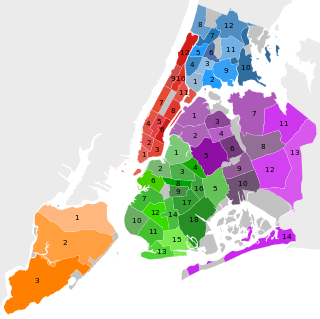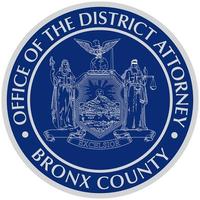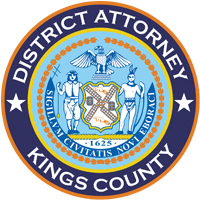
The New York City Council is the lawmaking body of New York City in the United States. It has 51 members from 51 council districts throughout the five boroughs.
The following is a list of topics related to New York City, New York, United States.
The borough presidents are the chief executives of the five boroughs of New York City. For most of the city's history, the office exercised significant executive powers within each borough, and the five borough presidents also sat on the New York City Board of Estimate, which was abolished in 1990. After the Board of Estimate was disbanded, the borough presidents were stripped of a majority of their powers in the government of New York City.

The New York City Board of Estimate was a governmental body in New York City responsible for numerous areas of municipal policy and decisions, including the city budget, land-use, contracts, franchises, and water rates. Under the amendments effective in 1901, to the charter of the then-recently-amalgamated City of Greater New York, the Board of Estimate and Apportionment was composed of eight ex officio members: the Mayor of New York City, the New York City Comptroller and the President of the New York City Board of Aldermen, each of whom had three votes; the borough presidents of Manhattan and Brooklyn, each having two votes; and the borough presidents of the Bronx, Queens, and Richmond, each having one vote. The 1897 charter effective on amalgamation had had a five-member Board of Estimate and Apportionment. The La Guardia Reform Charter of 1938 simplified its name and enhanced its powers.

The community boards of the New York City government are the appointed advisory groups of the community districts of the five boroughs. There are currently 59 community districts: twelve in the Bronx, eighteen in Brooklyn, twelve in Manhattan, fourteen in Queens, and three in Staten Island.

The District Attorney of Queens County is the elected district attorney for Queens County in New York State, coterminous with the New York City borough of Queens. The office is responsible for the prosecution of violations of New York state laws.. The current Queens County District Attorney is Melinda Katz, who assumed the duties of the office on January 1, 2020. There was an inauguration on January 6, 2020 at her alma mater, St. Johns University.

The Bronx County District Attorney is the elected district attorney for Bronx County, which is coterminous with the Borough of the Bronx, in New York City. The office is responsible for the prosecution of violations of New York state laws.. The current Bronx County District Attorney is Darcel Clark.

The Kings County District Attorney's Office, also known as the Brooklyn District Attorney's Office, is the district attorney's office for Kings County, coterminous with the Borough of Brooklyn, in New York City. The office is responsible for the prosecution of violations of the laws of New York.. The current district attorney is Eric Gonzalez.

The New York City Board of Aldermen was a body that was the upper house of New York City's Common Council from 1824 to 1875, the lower house of its Municipal Assembly upon consolidation in 1898 until the charter was amended in 1901 to abolish the Municipal Assembly and its upper house, and its unicameral legislature from 1875 to 1897 and 1902 to 1937. The corresponding lower house was known as the Board of Assistants or the Board of Assistant Aldermen from 1824 to 1875, while the upper house was known as the Council from 1898 to 1901. In 1938 a new charter came into effect that replaced the Board of Aldermen with the New York City Council.
Martin F. Tanahey was an American politician who was the alderman of New York City's 1st district from 1922 to his death in 1930. A Democrat, he served much of the Lower East Side and Financial District in Manhattan.

Elections were held on November 2, 1937 to fill the New York City Council, which had just been formed to replace the New York City Board of Aldermen. The new Council comprised 26 members elected via proportional representation by borough, in contrast to the 65-member Board of Aldermen elected by district. This was done in response to the large majorities the Democrats often received in the Board of Aldermen. Each borough was entitled to one member of the council for each 75,000 votes cast, and an additional member for each remainder greater than 50,000. Due to voter turnout, Brooklyn was entitled to nine members of the Council, Manhattan six, Queens and The Bronx five each, and Richmond one.

Elections of New York City's borough presidents were held on November 5, 1929, in concert with such contests as the mayoralty, Comptroller, aldermen, County Sheriffs, Aldermanic Board President, and other miscellaneous questions on the ballot. Democrats were elected in all Boroughs except Queens. This and Democratic victories in other contests were all a part of what was considered "a Crushing Defeat to [the] City G.O.P. [delivered]" by Tammany Hall.

An election was held on November 5, 1929, to elect the President of the New York City Board of Aldermen, in concert with other such contests as the mayoralty, Comptroller, the remainder of the Board of Aldermen, County Sheriffs, Borough presidents, and other miscellaneous questions on the ballot. Democratic incumbent Joseph V. McKee of The Bronx defeated Republican candidate Bird Sim Coler of Brooklyn, himself an independent Democrat, 890,655 votes to 385,514. This combined with Democratic victories in other contests formed what was considered "a Crushing Defeat to [the] City G.O.P. [delivered]" by Tammany Hall.

An election was held in New York City to election the President of its Council on November 2, 1897. The charter of the new City of Greater New York had created a bicameral Municipal Assembly, comprising an upper Council and a lower Board of Aldermen. The Council president was elected citywide while the Board of Aldermen elected its own president.

The 1929 New York City mayoral election was held on November 5 in concert with other municipal elections. Democratic incumbent Jimmy Walker defeated Republican challenger Fiorello H. La Guardia in what was considered "a Crushing Defeat to [the] City G.O.P. [delivered]" by Tammany Hall. Socialist candidate Norman Thomas also ran, as did Socialist Labor candidate Olive M. Johnson and former Police Commissioner Richard Edward Enright for the Square Deal Party.
Augustus F. Pierce was an American politician who served as the Tammany Hall leader of the Bronx's 8th assembly district in New York City until his death in 1934. An employee of the city since 1907, at the time of his death he worked for the Department of Sanitation.

New York City was divided into wards between 1683 and 1938. These were used for the election of various municipal offices, and would later be used to construct the boundaries of larger electoral districts. Prior to the formation of the so-called City of Greater New York in 1898, what is now New York City comprised multiple municipalities that had different histories with wards.

Queens Directories – of New York City – were, before 1898, an assortment of village directories, Queens County directories, Long Island Directories, and add-ins or partial inclusions to New York City directories. In 1898, 30% of the western part of the old Queens County was absorbed into New York City. Before 1898, Nassau County covered the eastern 70% of the old Queens County. The older, larger Queens County was mostly agricultural, and within it were several towns, villages, and hamlets. In the mid- to late-19th century, cemeteries constituted one of the larger industries in Queens, Kings (Brooklyn), and Westchester Counties. As of 1898, Queens County, New York, and the Borough of Queens, New York City, geographically, have been the same. Both Queens and Brooklyn are on Long Island.

Lyman Williams Redington was an American attorney and politician who was active in Vermont and New York. A Democrat, he served in the Vermont House of Representatives from 1880 to 1882, and the New York State Assembly from 1898 to 1900. In addition, as a Democrat during the more than 100 years when Republicans won every statewide election and contest for federal office, Redington was also an unsuccessful candidate for Vermont's 1st district seat in the United States House of Representatives in 1882, and governor of Vermont in 1884.















